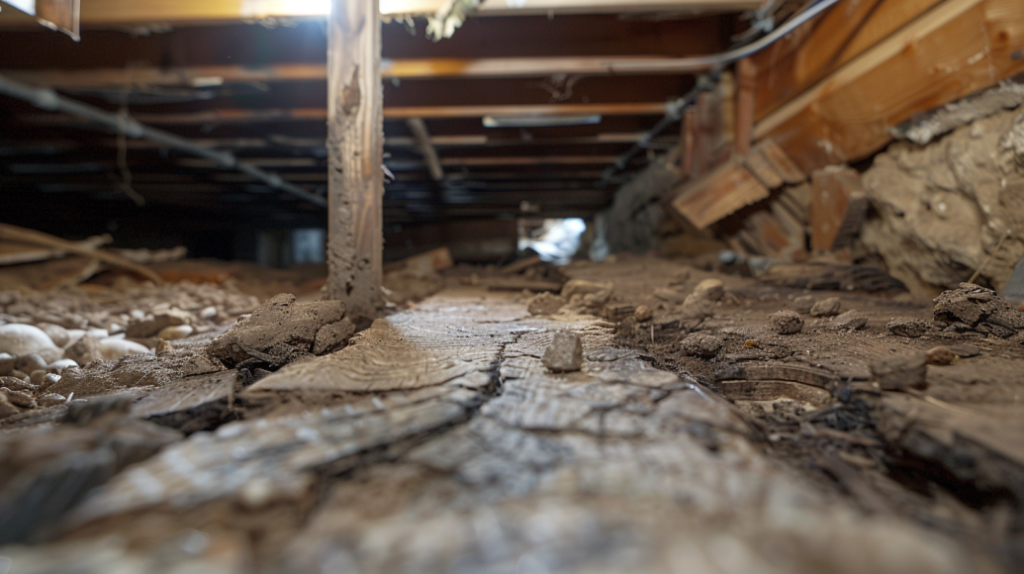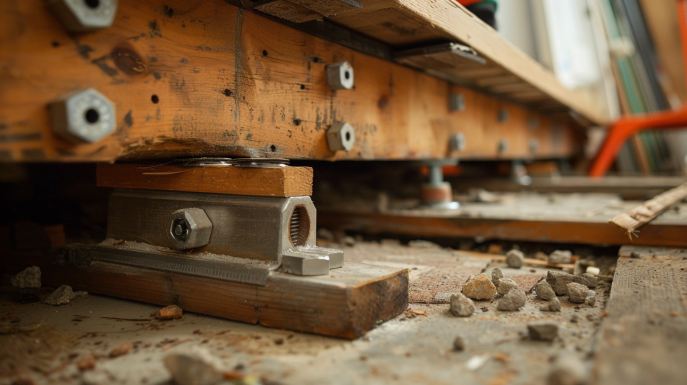When floor joists begin to sag, it’s crucial to address the issue promptly to maintain your home’s stability. By recognizing the signs of sagging, pinpointing the underlying causes, and implementing reinforcement methods, you can effectively combat the problem.
Restoring the structural integrity of your home involves understanding and addressing sagging floor joists to ensure a secure living environment.
Identifying Signs of Sagging
Signs of sagging floor joists can be seen through uneven floors, gaps between the floor and walls, and sloping surfaces.
Uneven floors show dips or rises, while gaps indicate insufficient support.
Sloping surfaces can be detected with a level.
Recognizing these signs early helps address the issue promptly.
Understanding the Causes

Moisture, age, and structural issues are the main reasons behind sagging floor joists.
Moisture weakens the wood, making it warp and sag over time. As materials age, they lose strength and stability, contributing to sagging. Structural problems like inadequate support or heavy walls can also strain floor joists, causing them to sag.
Identifying these causes is important to fix the problem. By dealing with moisture, reinforcing weak joists, and fixing structural issues, you can prevent further damage and keep your home strong and stable.
Impact of Prolonged Sagging
Ignoring sagging floor joists can weaken your home’s structure and create safety risks.
Excessive weight on the joists can lead to cracks in walls, ceilings, or the foundation.
Promptly addressing sagging joists is vital to prevent further damage and costly repairs.
Act quickly to maintain your home’s stability and safety for your family.
DIY Assessment for Homeowners
Regularly check your floors for sagging to maintain safety and structure. Here’s how:
- Check Crawl Spaces: Look under your home for any sagging or uneven wood joists.
- Inspect Wood: Check for cracks, splits, or water damage in the floor joists.
- Use Simple Tools: Use a level to check for flatness in different areas.
- Measure and Document: Measure sagging areas and track changes over time.
Temporary Supports
Inspect your sagging floor joists for damage and install temporary supports like adjustable posts or beams for safety. Place the supports under the affected joists securely on the foundation, following guidelines for proper positioning.
Consult a professional if needed to ensure the supports can bear the structure’s weight. Temporary supports create a safer environment for repairs and prevent further damage.
Read how to repair floor joists
Sistering Technique
- Assessment:
Identify the damaged joists and measure the length needing reinforcement.
- Lumber Selection:
Choose strong lumber matching existing joist dimensions.
- Installation:
Place new lumber next to the old joist for full support.
- Fastening:
Secure the sister joist tightly with nails or screws for added strength.

Adjusting and Leveling
Adjusting and leveling sagging floor joists is crucial for structural stability and a flat floor.
Key techniques include:
- Shimming: Using tapered wedges to raise joists with shims and a hammer.
- Blocking: Adding wood blocks between joists for support using wood blocks and nails.
- Jacking: Lifting sagging areas with hydraulic jacks.
Follow precise measurements and ensure uniform adjustments to prevent further sagging or unevenness.
Reinforcement Methods
Considering severe sagging floor joists, using steel brackets or plates is crucial for structural stability. When facing significant sagging, these methods are necessary to prevent further damage and maintain floor system integrity.
Here are four key aspects to consider when using steel brackets or plates for reinforcement:
- Assess Sagging Severity: Accurately assess sagging extent to determine the type and placement of steel brackets or plates.
- Install Properly: Follow manufacturer guidelines for optimal support and load distribution.
- Use Quality Materials: Select high-quality steel brackets or plates designed for structural reinforcement.
- Seek Professional Advice: Consult a structural engineer or contractor for guidance on the reinforcement process.
Preventive Measures
Regular maintenance and prompt action are key to preventing floor joist sagging.
Inspect for water damage, excess moisture, weak soil, or improper joist placement. Look out for cracks, warping, or strange sounds indicating issues. Don’t delay seeking professional help if problems arise.
Keep gutters clean, ensure proper drainage, and monitor humidity levels to prevent moisture damage. Also, maintain good ventilation in crawl spaces and attics.
FAQ On Sagging Floor Joists
How Do You Reinforce Sagging Floor Joists?
To reinforce sagging floor joists, you can sister weakened joists for added support. Consider using steel or plywood flitch plates for strengthening. Adding blocking between joists helps distribute weight evenly. Professional help may be necessary for severe cases.
How Do You Stabilize Floor Joists?
To stabilize floor joists, identify causes like water damage or weak soils. Solutions may involve sistering for reinforcement or jacking for support. Addressing promptly prevents safety hazards. Regular checks and expert advice maintain a healthy foundation.
How Do I Know if My Floor Joists Are Sagging?
To determine if floor joists sag, inspect for sloping, bouncy floors, wall/ceiling cracks, gaps at floor-baseboards, and uneven areas with a level. Note misaligned doors/windows and musty odors/mold. Address promptly for safety.
What Is Sagging in Floor Joists Typically Caused By?
Sagging in floor joists is typically caused by moisture damage leading to wood rot and weakening of the structural members. Termite infestations can also contribute by eating away at the wood, compromising its integrity.
